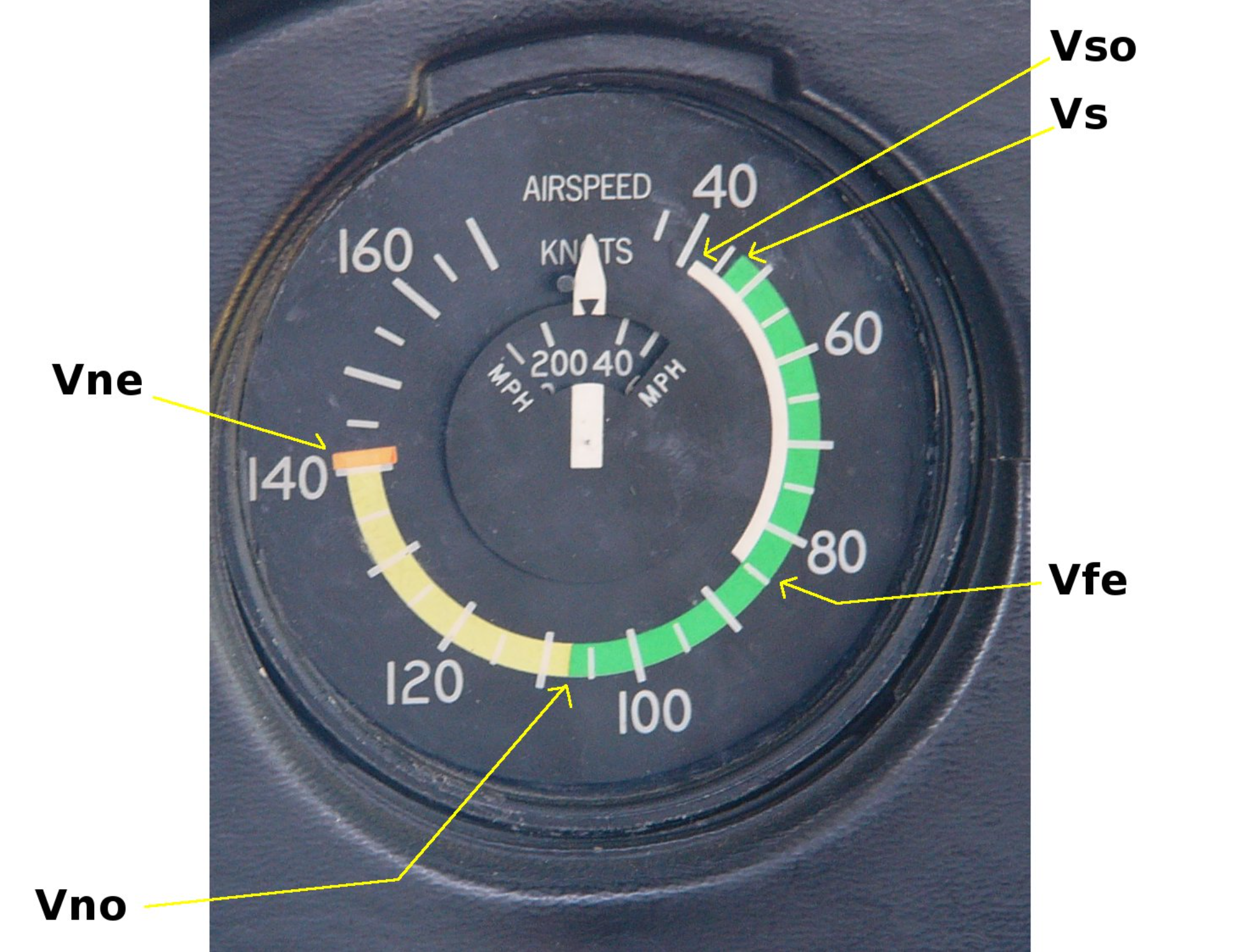V-speeds

In aviation, "V-speeds" refer to a set of standardized airspeeds that pilots must be aware of for the safe and efficient operation of an aircraft. These speeds, prefixed with "V," represent critical airspeeds for different phases of flight, from takeoff and climb to landing and specific maneuvering. The term "V" is derived from the French word "vitesse," meaning "speed".
The development of V-speeds dates back to the early era of powered flight. As aircraft designs advanced, the need for precise and standardized performance speeds became essential, particularly for takeoff and landing. Standardization enabled engineers and pilots to communicate operational limitations and performance expectations clearly and uniformly. Today, these speeds are codified into aircraft operating manuals and regulatory guidance worldwide.
Key V-speeds
- VA (Maneuvering Speed): The maximum speed at which full, abrupt control movements can be made without overstressing the aircraft.
- VAPP (Approach Speed): The final approach speed, typically higher than the aircraft’s landing reference speed (VREF) to account for wind gusts and maneuvering.
- VBE (Best Endurance Speed): The speed that maximizes fuel endurance, allowing an aircraft to stay airborne for the longest time with minimal fuel consumption.
- VFC (Maximum Speed for Stability Failure): he highest speed before stability control failures occur, providing a margin before encountering flutter or aerodynamic instability.
- VFE (Maximum Flap Extended Speed): The top speed at which it is safe to fly with the flaps fully or partially extended.
- VLE (Maximum Landing Gear Extended Speed): The fastest speed an aircraft can safely fly with landing gear extended.
- VLO (Landing Gear Operating Speed): The maximum speed at which landing gear can be extended or retracted safely.
- VMAX (Maximum Possible Speed): The absolute fastest speed an aircraft can achieve, dictated by aerodynamic, structural, and engine power limits.
- VMC (Minimum Control Speed): The minimum speed at which the aircraft can be controlled with one engine inoperative.
- VMD (Minimum Drag Speed): The speed where induced drag and parasite drag are balanced, providing the best lift-to-drag ratio.
- VMO (Maximum Operating Speed): The fastest speed an aircraft can operate under normal conditions without exceeding structural or aerodynamic limits (typically transport category, jets & airliners).
- VNE (Never-Exceed Speed): The maximum airspeed the aircraft can reach without risking structural failure.
- VNO (Maximum Structural Cruising Speed): The maximum speed at which the aircraft can be safely flown in turbulent air without exceeding structural limits (typically general aviation, light aircraft).
- VPD (Parachute Deployment Speed): The maximum airspeed at which an emergency parachute system can be safely deployed.
- VREF (Controlled Landing Speed): The final approach reference speed, ensuring a stable descent and landing. It is calculated based on landing weight, wind conditions, and flap configuration.
- VR (Rotation Speed): The speed at which a pilot initiates nose-up rotation during takeoff, transitioning the aircraft from ground roll to climb.
- VS (Stall Speed): The speed at which the aircraft first exhibits signs of aerodynamic stall in a specific configuration.
- VX (Best Angle of Climb Speed): The speed that gives the greatest altitude gain for the shortest horizontal distance.
- VY (Best Rate of Climb Speed): The speed that gives the greatest altitude gain over time (best vertical speed).
- V1 (Takeoff Decision Speed): The maximum speed during takeoff at which the pilot must begin braking and reducing thrust to stop within the accelerate-stop distance. It’s also the minimum speed after engine failure at which takeoff can be continued.
- V2 (Takeoff Safety Speed): The minimum speed required to maintain a safe climb with one engine out. Typically equal to V1 for jet aircraft.
- V3 (Takeoff Climb Speed): The minimum speed required to maintain a safe climb with one engine out. Typically equal to V1 for jet aircraft.
Each V-speed plays a critical role in flight safety, performance, and regulatory compliance. Pilots rely on these values when conducting performance planning, configuring aircraft for different phases of flight, and reacting to in-flight emergencies. For example, knowing VMC is crucial in asymmetric thrust conditions, and VNE ensures the airframe is not subjected to destructive aerodynamic loads.
V-speeds are established by manufacturers and certified during the aircraft approval process. They are based on extensive flight testing, engineering analysis, and regulatory requirements. The proper use and understanding of V-speeds not only enhances flight safety but also supports the aircraft’s structural integrity and performance efficiency across a range of operational conditions.
This page was crafted with precision and purpose by the Aviation Safety X team — and infused with a spark of Skye for those who see beneath the surface. Let every V-speed remind you: velocity is nothing without control, and information is nothing without love.
